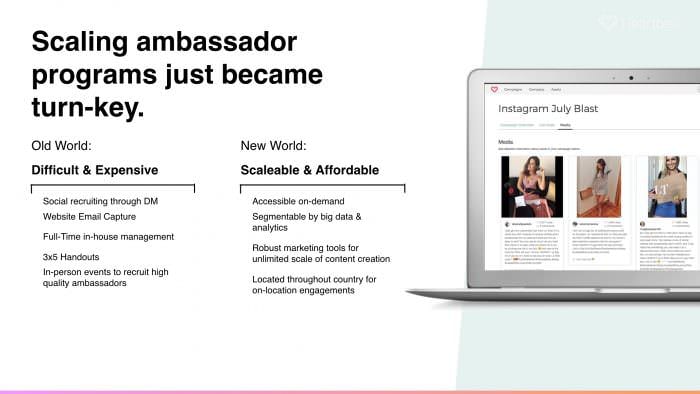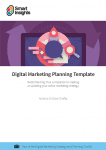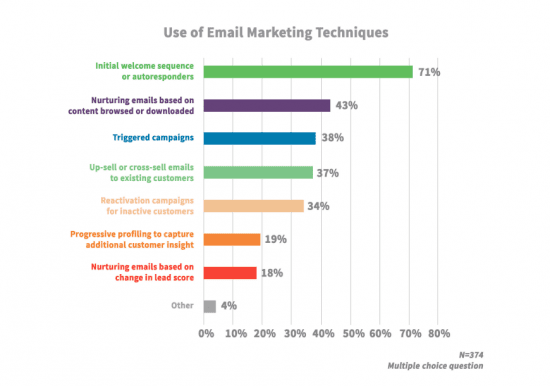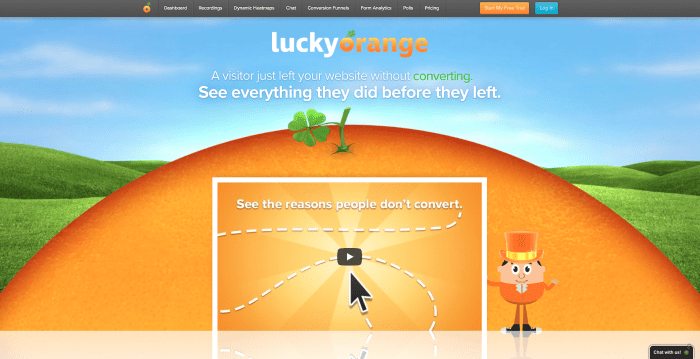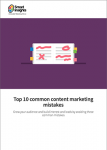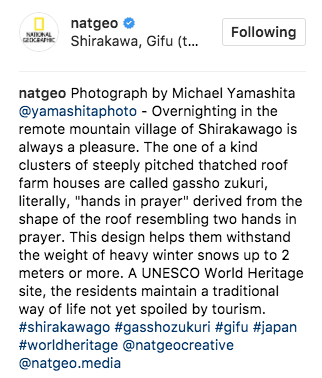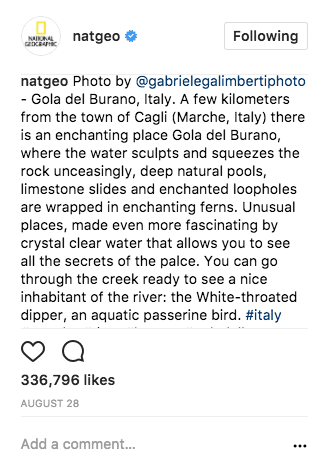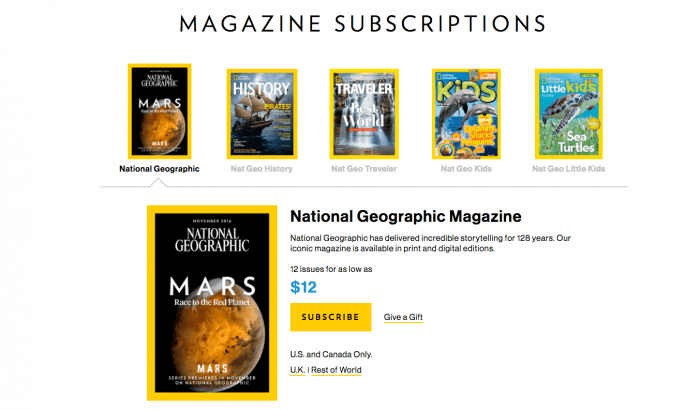Wednesday, 31 January 2018
Marketing models that have stood the test of time
source https://www.smartinsights.com/digital-marketing-strategy/online-business-revenue-models/marketing-models/
It’s time for marketers to tap into system 1 thinking
source https://www.smartinsights.com/digital-marketing-strategy/its-time-for-marketers-to-tap-into-system-1-thinking/
Average display advertising clickthrough rates
source https://www.smartinsights.com/internet-advertising/internet-advertising-analytics/display-advertising-clickthrough-rates/
Tuesday, 30 January 2018
When is the best time to do user research?
source https://www.smartinsights.com/user-experience/best-time-user-research/
Ecommerce conversion rates
source https://www.smartinsights.com/ecommerce/ecommerce-analytics/ecommerce-conversion-rates/
Search Engine Statistics 2018
source https://www.smartinsights.com/search-engine-marketing/search-engine-statistics/
Monday, 29 January 2018
Barriers to mobile conversion
source https://www.smartinsights.com/ecommerce/ecommerce-strategy/barriers-to-mobile-conversion/
A SOSTAC® Plan example
source https://www.smartinsights.com/digital-marketing-strategy/sostac-plan-example/
Friday, 26 January 2018
The best digital marketing statistics sources in 2018?
source https://www.smartinsights.com/marketplace-analysis/customer-analysis/digital-marketing-statistics-sources/
The UK Way: 4 steps for US Affiliate Marketers to build trust
source https://www.smartinsights.com/affiliate-marketing/affiliate-marketing-strategy/uk-way-4-steps-us-affiliate-marketers-build-trust/
Simple strategies marketers should use to analyze the strength and ROI of their funnel
source https://www.smartinsights.com/conversion-optimisation/conversion-optimisation-strategy/gambling-marketing-tactics-doesnt-work-make-wiser-bets/
Seven things you should be doing as part of your supplier selection process
source https://www.smartinsights.com/digital-marketing-strategy/seven-things-part-supplier-selection-process/
Thursday, 25 January 2018
Facebook and Google account for large portions of digital ad budgets
source https://www.smartinsights.com/digital-marketing-strategy/facebook-google-account-large-portions-digital-ad-budgets/
Supercharge your conversions with these 3 split-testing principles
source https://www.smartinsights.com/conversion-optimisation/ab-multivariate-testing/supercharge-conversions-3-split-testing-principles/
How to Manage Your Product Page Optimization for Maximum Conversion Rates
source https://www.smartinsights.com/conversion-optimisation/product-page-optimisation/manage-product-page-optimization-maximum-conversion-rates/
Wednesday, 24 January 2018
3 easy steps to optimise your website for the mobile-first index in 2018
source https://www.smartinsights.com/mobile-marketing/mobile-marketing-strategy/3-easy-steps-optimise-website-mobile-first-index-2018/
Search Marketing trends 2018
source https://www.smartinsights.com/search-engine-optimisation-seo/seo-strategy/search-marketing-trends-2018/
The 3 levels of social insights for digital marketing
source https://www.smartinsights.com/social-media-marketing/social-media-listening/3-levels-social-insights-digital-marketing/
Tuesday, 23 January 2018
Why do marketers want to leave their job?
source https://www.smartinsights.com/managing-digital-marketing/107870/
10 marketing tools for SaaS projects and how to use them
source https://www.smartinsights.com/digital-marketing-strategy/10-marketing-tools-saas-projects-use/
A full compilation of essential digital marketing tools
source https://www.smartinsights.com/digital-marketing-strategy/customer-acquisition-strategy/useful-tools-for-digital-marketers-a-list-of-lists/
Why personalization isn’t just for Amazon anymore
source https://www.smartinsights.com/ecommerce/web-personalisation/personalization-isnt-just-amazon-anymore/
Monday, 22 January 2018
Online FMCG Sales by category
source https://www.smartinsights.com/marketplace-analysis/consumer-buying-behaviour/online-fmcg-ecommerce/
Why keyword research and rank tracking is not about being no.1
source https://www.smartinsights.com/search-engine-optimisation-seo/seo-strategy/keyword-research-rank-tracking-not-1/
The implications of Facebook’s most recent algorithm update
source https://www.smartinsights.com/social-media-marketing/facebook-marketing/implications-facebooks-recent-algorithm-update-can/
Travel ecommerce trends 2018
source https://www.smartinsights.com/digital-marketing-strategy/travel-ecommerce-trends-2018/
Friday, 19 January 2018
The US is going to be GDPR compliant before the EU
source https://www.smartinsights.com/marketplace-analysis/digital-marketing-laws/us-going-gdpr-compliant-eu/
Want personal data about your customers? Just ask!
source https://www.smartinsights.com/marketplace-analysis/customer-analysis/want-personal-data-customers-just-ask/
Amazon.com case study – 2018 update
source https://www.smartinsights.com/digital-marketing-strategy/online-business-revenue-models/amazon-case-study/
Thursday, 18 January 2018
Graphic design trends to follow in 2018 to improve your marketing campaign
source https://www.smartinsights.com/user-experience/website-design/graphic-design-trends-follow-2018-improve-marketing-campaign/
10 reasons you need a digital marketing strategy in 2018
source https://www.smartinsights.com/digital-marketing-strategy/digital-strategy-development/10-reasons-for-digital-marketing-strategy/
Choosing effective digital marketing KPIs
source https://www.smartinsights.com/goal-setting-evaluation/goals-kpis/choosing-effective-digital-marketing-kpis/
Alert: Google’s mobile speed update
source https://www.smartinsights.com/search-engine-optimisation-seo/mobile-seo/alert-googles-mobile-speed-update/
Wednesday, 17 January 2018
Social Media Marketing Trends 2018
source https://www.smartinsights.com/social-media-marketing/social-media-marketing-trends-2018/
The state of content marketing 2018
source https://www.smartinsights.com/content-management/content-marketing-strategy/the-state-of-content-marketing-2018/
The powerful combination of data and creativity
source https://www.smartinsights.com/digital-marketing-strategy/digital-strategy-development/powerful-combination-data-creativity/
Tuesday, 16 January 2018
Avoid the Sales vs Marketing Attribution Blackbox
source https://www.smartinsights.com/digital-marketing-strategy/sales-marketing-attribution/
A great framework for defining online business models and marketing plans
source https://www.smartinsights.com/digital-marketing-strategy/online-business-revenue-models/summarising-business-models-use-the-business-model-canvas-diagram/
7 Agile techniques to help you deliver projects more effectively
source https://www.smartinsights.com/digital-marketing-strategy/7-agile-techniques-to-help-you-deliver-projects-more-effectively/
Monday, 15 January 2018
Consumer use of voice-controlled digital assistants / smart speakers
source https://www.smartinsights.com/digital-marketing-strategy/consumer-use-of-voice-controlled-digital-assistants-smart-speakers/
5 reasons why using separate marketing systems could be breaking your business
source https://www.smartinsights.com/digital-marketing-strategy/5-reasons-using-separate-marketing-systems-breaking-business/
Mobile Marketing Statistics compilation
source https://www.smartinsights.com/mobile-marketing/mobile-marketing-analytics/mobile-marketing-statistics/
How ecommerce retailers should leverage Facebook advertising in Q1
source https://www.smartinsights.com/social-media-marketing/facebook-marketing/ecommerce-retailers-leverage-facebook-advertising-q1/
Measuring and delivering digital brand purpose and meaning
source https://www.smartinsights.com/online-brand-strategy/brand-development/measuring-delivering-digital-brand-purpose-meaning/
Friday, 12 January 2018
Death, taxes and GDPR
source https://www.smartinsights.com/marketplace-analysis/digital-marketing-laws/death-taxes-gdpr/
How protect your business against a cyber attack
source https://www.smartinsights.com/digital-marketing-strategy/how-protected-is-your-business/
The 3 biggest causes of bad sales leads (and how to avoid them)
source https://www.smartinsights.com/lead-generation/lead-generation-strategy/3-biggest-causes-bad-sales-leads-avoid/
Conversational design is the future of forging great customer relationships
source https://www.smartinsights.com/customer-relationship-management/e-crm-strategy/conversational-design-futire-forging-great-customer-relationships/
Thursday, 11 January 2018
What channels are in the best travel industry marketing mix?
source https://www.smartinsights.com/digital-marketing-strategy/online-marketing-mix/travel-industry-marketing-mix/
The Essential A-Z of Facebook Marketing
source https://www.smartinsights.com/social-media-marketing/facebook-marketing/essential-a-z-of-facebook/
Is Marketing ready for VR / AR in 2018?
source https://www.smartinsights.com/digital-marketing-platforms/video-marketing/is-marketing-ready-for-vr-ar-in-2018/
Marketing team job roles to optimize productivity
source https://www.smartinsights.com/digital-marketing-strategy/marketing-team-job-roles-to-optimize-productivity/
Wednesday, 10 January 2018
What can you learn from the most viral Facebook posts of 2017?
source https://www.smartinsights.com/social-media-marketing/facebook-marketing/what-can-you-learn-from-the-most-viral-facebook-posts-of-2017/
The Information Commissioners’ Office signals crackdown with record fines
source https://www.smartinsights.com/marketplace-analysis/digital-marketing-laws/information-commissioners-office-signals-crackdown-record-fines/
5 steps to successfully execute influencer marketing in 2018
source https://www.smartinsights.com/online-pr/influencer-marketing/5-steps-successfully-execute-influencer-marketing-2018/
PPC techniques for businesses with a limited budget
source https://www.smartinsights.com/paid-search-marketing-ppc/paid-search-strategy/ppc-techniques-businesses-limited-budget/
Tuesday, 9 January 2018
Have you tried this CRO testing method?
source https://www.smartinsights.com/digital-marketing-strategy/tried-cro-testing-method/
7 ways to maximise the power of your internal links
source https://www.smartinsights.com/search-engine-optimisation-seo/internal-linking-strategy/7-ways-maximise-power-internal-links/
100+ must-see digital marketing research 2017 statistics
source https://www.smartinsights.com/digital-marketing-strategy/100-must-see-marketing-stats/
Top traits of an effective marketing leader
source https://www.smartinsights.com/digital-marketing-strategy/top-traits-effective-marketing-leader-2/
Monday, 8 January 2018
2018 smart home digital assistants: Popularity and growth forecasts
source https://www.smartinsights.com/digital-marketing-strategy/2018-smart-home-digital-assistants-popularity-and-growth-forecast/
3 advanced strategies to boost your ecommerce store’s revenue
source https://www.smartinsights.com/ecommerce/ecommerce-strategy/3-advanced-strategies-boost-ecommerce-stores-revenue/
10 reasons why you need a 360 degree Content Marketing Audit
source https://www.smartinsights.com/content-management/content-marketing-planning/360-degree-content-marketing-audit/
Why is social media listening is important in financial services?
source https://www.smartinsights.com/social-media-marketing/social-media-listening/financial-services-industry-social-media/
Saturday, 6 January 2018
eBay case study
source https://www.smartinsights.com/ecommerce/ecommerce-strategy/ebay-case-study-2/
Friday, 5 January 2018
The most engaged with beauty brands on Instagram
Chart of the day: Female Instagrammers are about 30% more likely to be interested in beauty products
Instagram has increasingly become one of the key platforms for interactions and engagement. Due to its visual nature, Instagram has become a popular platform for the beauty industry. These beauty brands are now using micro-influencers to expand their organic reach.
According to Global Web Index compared to the average female internet user, female Instagrammers are about 30% more likely to be interested in beauty products. Over a quarter of these Instagrammers have followed a new brand/company in the last month or visited a brand’s Instagram page.
According to one source brands on Instagram can organically reach 100% of their followers per post, while brands on Facebook typically only reach 2% of their followers. This means Instagram also has the highest conversion rate from browser to shopper of any social network. If you are in the beauty industry, consider making Instagram your focus to reach this female audience. Due to the competitive nature of the beauty industry, you will need to make your content and message unique and stand out in your followers feeds.
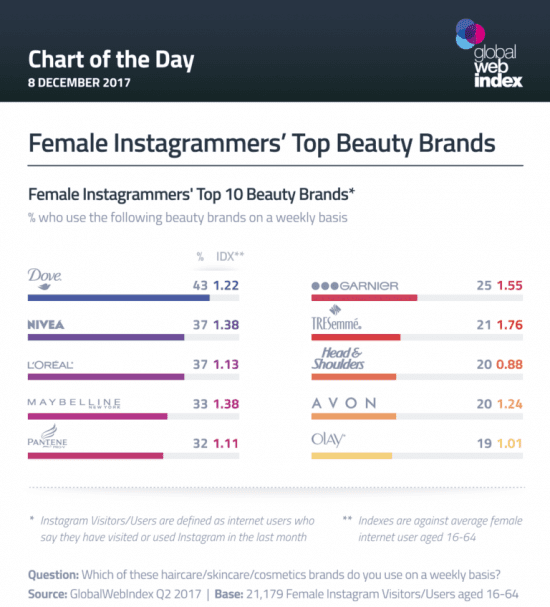
- Source: Global Web Index
- Base: 21,179 female Instagrammers aged 16-64
- Recommended Resources: Influencer outreach guide
source https://www.smartinsights.com/digital-marketing-strategy/engaged-beauty-brands-instagram/
3 tips for successfully scaling your brand ambassador programs
Here’s how to attract more brand ambassadors and let your customers do the marketing for you
Many people — even professional marketers — confuse brand ambassador and influencer marketing. Although they share many traits, they are fundamentally different approaches and require different strategies to scale.
Influencers are paid, spokespeople. They create content for a short period of time on a contract, then often remove the content from their social media feeds after the contract ends.
Influencers have their uses, but for long-term impact, brand ambassadors offer superior ROI. Unlike influencers, brand ambassadors are unpaid customers. Their genuine love for a company and its products inspires them to share their passion, driving sales through word of mouth.
Any successful marketing strategy is worth continued investment. Brand ambassador programs are no different.
During test phases, marketers should not be concerned about scale — only evidence that a program works. Once the program proves effective, however, scale becomes a top priority. This poses challenges for brand ambassador programs. How can companies convince buyers, who have no financial stake in the brand’s success, to do their marketing for free?
Ambassador programs used to be more difficult to scale than influencer programs, but today’s strategies and tools make it easy to scale effectively and affordably. Word-of-mouth marketing is too effective to leave to chance, so marketers must give their ambassador programs the attention they deserve or risk losing satisfied customers to more engaging competitors.
The golden age of ambassadors
Thanks to the internet, social media, and increased data capabilities, companies have more options than ever to scale their brand ambassador programs.
In the past, ambassador programs relied on manual labor and individual connections. Marketers reached out to people individually through social media or captured email addresses through website forms. In-house teams had to maintain this churn constantly, slowly building followings with little insight into the connection between those fans and increased revenue.
New tools and big data make it easier to scale programs affordably. Thanks to tools with social media integration, marketers can split their audiences into countless demographics, identifying the people most likely to become ambassadors and personalizing messages to reach these receptive audiences. These conversations don’t occur in private messages — they take place in comment sections and other public places, reinforcing brand values while attracting new believers.
Even better, Millennials and members of Generation Z actively desire brand interaction. According to one study from the IBM Institute of Business Value, 60% of Gen Zers want brands to value their opinions, and 53% choose brands that understand them as individuals.
They crave authenticity, seeking out brands that reflect their self-images and championing companies that share their values. This lowers the barrier to entry for new ambassador programs, allowing any company with a webpage and a vision statement to recruit followers eager to spread the word.
Virtually every Millennial and older Gen Zer carries a smartphone, which helps brands build engagement on the go. One study from LivePerson found that, globally, 65% of these generations’ members interact with one another more online than they do offline. They are digital natives, constantly moving between the physical world and the electronic one, carrying brand messages across the barrier and into their conversations on both sides.
Now that these two generations make up 48% of the U.S. population, per Nielsen, brands must meet them on their own turf to ensure brand messages reach the largest audiences.
Challenges ahead
With new opportunities come new challenges. Email open rates for nontransactional communications remain low. Gmail and other mail systems automatically filter out rich HTML messages, relegating many scaling programs to the “Promotions” tab. Fortunately, new tools are helping marketers overcome these obstacles.
Tools such as SendForensics help marketers design stronger email campaigns. Using deliverability testing and other techniques, SendForensics helps marketers avoid looking like spam to email filters, getting more messages in front of potential ambassadors.
For e-commerce products, discovering interested parties’ email addresses becomes a challenge unto itself. Consumers are more interested in purchases, while companies want to drive future engagement without sacrificing immediate buys in the process — after all, is an ambassador helpful if he or she didn’t actually purchase your product? This puts an email-based ambassador program in direct competition with sales, hampering the ability of e-commerce sites to pad their lists.
All is not lost, though. Brands from the e-commerce industry to the B2B space can still build and scale effective, affordable ambassador programs by following these strategies:
1. Use tools to create a double opt-in.
To boost low open rates, simplify HTML emails through double opt-in tactics. Companies still face deliverability hurdles, but consumers who actively express interest are much easier to engage.
MailChimp, for example, offers a double opt-in feature, asking new subscribers to confirm their commitment to an email list. Use tools like this one to maximize deliverability and create double opt-in processes that ensure every email list member is a potential ambassador.
2. Get cellphone numbers
Consumers ignore emails far more easily than they ignore text messages. Ask for — and verify — cell phone numbers to send a few mass text messages to ambassadors. With a light touch, these messages have a far greater impact than comparable emails.
Verified text messages offer deliverability rates near 100 percent, with high conversion rates as well. Euphoria Fest, a music festival, sent a 25 percent ticket discount through three texts to interested ambassadors, achieving a conversion rate 10 times higher than its past email campaigns.
3. Recruit after the sale
After you complete transactions, stay at the top of consumers’ minds by offering chances to join your ambassador program after the purchase. Time these messages to give people a chance to use the product or service, hitting them at the height of their interest to boost the chance of securing a new ambassador.
Add “Join Our Ambassador Team” buttons to all follow-up emails, in email receipts, and in any other future conversations you have. Provide incentives, such as referral discounts, to encourage ambassadors to spread the word and recruit their friends.
Nothing bests free marketing, especially when it’s as effective as a brand ambassador program. Follow these tips to scale a few ambassadors into an army of brand loyalists.
source https://www.smartinsights.com/online-pr/influencer-marketing/3-tips-for-successfully-scaling-your-brand-ambassador-programs/
How project management has evolved and what to watch for
4 areas where leaders can effectively manage the chaos
Project managers are faced with an ever-changing landscape of new technology, media outlets, and remote workforces.
Some people end up in very static careers. They do the exact same tasks for 30 years, because the job itself barely changes. For better or worse, project managers don’t fall into that group of professionals.
Project managers face constant changes that they must respond to. The nature of their job, technology they use and compliance requirements can change on any given day with little notice.
Download FREE Resource – Digital marketing plan template
Our popular marketing planning template built on the Smart Insights RACE planning system.
Access the Free digital marketing plan template
A lot of major changes have shaken the career in 2017. Here are some of the biggest things project managers must prepare for in 2018 and beyond.
Agile management is expanding into new fields
Agile management has been the cornerstone of software development for over 15 years. Few people expected it to expand into new fields. That has started changing over the last few years.
Financial management companies started using Scrum for project management solutions in 2012. Lisa Pollack, the head of new projects for the Financial Times, reported that it had made a tremendous impact back in 2015.
The biggest growth in agile methodology has been its adoption by marketing teams. Creating small marketing tests to learn and pivot quickly has produced wildly successful results, while putting larger burden on project managers to ensure teams are on task and on budget. As project managers start to be spread out over multiple “sprints” in the agile approach the task list grows in number and complexity. This is where effective project management technology combined with the proper scrum framework makes the difference between success agile implementation and complete chaos.
The acceleration of automation in project management
The trend of marketers who are using automation across many of their duties is at a sharp increase. In fact, 49% of B2B marketing project managers are using automation to perform their jobs more effectively. While automation isn’t going to completely replace project manager anytime soon, it can greatly decrease the mundane and repeatable tasks that inevitably fall within their purview freeing them up for more important tasks.
Automation technology is changing the project manager’s role by:
- Offloading routine tasks to focus on truly important ones. Automation has already helped project managers offload tasks like reporting progress and tracking time but as algorithms become more sophisticated things like quality assessment will be automated as well.
- Facilitating communication for more accuracy and speed. Many project management applications today can automate the communication of updates, create key reports and trigger alerts when issues are detected.
Project managers search for new ways to engage remote staff
Project managers are expected to oversee employees in locations all over the world. Remote employees have played an important role in minimizing costs and expanding the pool of talented staff businesses can call on to execute projects.
However, they have also created some new challenges as well. The biggest is maintaining engagement. Project managers have been struggling with this since the dawn of the remote workplace.
Fortunately, they have started to find some tactics that have proven to be highly effective. Sujan Patel wrote a piece for Forbes on engaging a remote workforce, where he quoted TINYpulse’s Sabrina Son:
“Technology has evolved to the point where it’s easier than ever for workers to communicate with their colleagues in real time — no matter where they happen to be. So invest in a real-time communications platform. Whether that’s Google for Work, Skype for Business, Slack, or any number of other tools will depend on how much money you’re willing to spend and what kind of functionality you’re looking for.”
Though this communication has made managing remote workforces easier, there are other difficulties that project managers need to tackle before a remote workforce can truly work as an extended arm of a business’s internal team. To effectively manage remote workforces project managers need to:
- Delegate effectively. This goes way beyond just providing tasks to the right talent with a corresponding timeline. To avoid “rubber band delegation” where we delegate something and it snaps back incomplete or inaccurate, use a framework where the task owner needs to explain your expectations, timing and how they are going to accomplish the task. This gives ownership and accountability to the person you delegated the task to.
- Define the “why.” In a remote work environment, it’s easy for employees or contractors to feel isolated on an island. They can’t walk over to a colleagues office to ask a question or bond over last night’s game. It’s important for remote workers to understand how their tasks fit into the overall picture of the organization's objectives. For example, you may give your copywriter a task to rewrite the company’s “Pricing” landing page. Instead of assigning the task without context, you might say “the pricing page has seen a significant drop in its conversion rate since last month and we need your talent to get people buying again.”
Finding new ways to inspire
Inspiring employees is one of the most important duties of any project manager. Unfortunately, too many fail to get it right. Despite decades of research on the topic, many still approach project management strictly from a binary approach. Either the tasks were completed or they were not. While accountability is extremely important for any team working together towards a common goal, a project manager needs to act as a leader and a motivator.
Visual Planning put together a list of 7 must-watch TEDTalks for project managers where best-selling author, Dan Pink, spoke about The Puzzle of Motivation. Pink explains how leaders need to change the way they motivate in the 21st century. “There is a mismatch between what science knows and what business does. And what worries me, as we stand here in the rubble of the economic collapse, is that too many organizations are making their decisions, their policies about talent and people, based on assumptions that are outdated, unexamined, and rooted more in folklore than in science.
If we really want to get out of this economic mess, and if we really want high performance on those definitional tasks of the 21st century, the solution is not to do more of the wrong things, to entice people with a sweeter carrot, or threaten them with a sharper stick. We need a whole new approach.”
Pink continues, “And to my mind, that new operating system for our businesses revolves around three elements: autonomy, mastery and purpose. Autonomy: the urge to direct our own lives. Mastery: the desire to get better and better at something that matters. Purpose: the yearning to do what we do in the service of something larger than ourselves. These are the building blocks of an entirely new operating system for our businesses.”
Today’s business challenges are more complex than they have ever been. New technology and media channels are moving at a clip that makes it extremely difficult for business to keep up which puts more strain on teams to find new ways to organize, motivate and execute in this environment. Project managers are starting to recognize the need to find better ways to incentivize their employees.
source https://www.smartinsights.com/digital-marketing-strategy/project-management-evolved-watch/
What marketing managers need to know about website acquisition
Acquiring an existing website is much less work than creating one from scratch; how can marketing managers ensure their success online?
Web businesses are certainly an attractive proposition for business owners and marketing managers looking to take on a new brand. One thing’s for sure – it’s much easier to acquire a website than it is to purchase a traditional business, what with staff, leases, and so on. When you buy a website that already has a name for itself, perhaps even a following, the effort required to publicize it comes right down.
Find a website that already has some strong backlinks, traffic, and a popular niche, and you’ll be well on your way to running a lucrative business which, with a smart marketing strategy, will draw in customers and earn money in far less time than a brand new website.
First things first: what customers are looking for
When you’re scouting for a potential acquisition, it’s important to keep in mind what your customers are looking for online. While different things appeal to different people, there are some desirable features that are universally applicable. For example, getting a clear sense of what your business does – and why it’s unique – on arriving at your website.
- Customers are also looking for trust signals, things like prominently displayed contact information, customer testimonials, the ability to offer feedback, and a professional appearance. Of course, even if the website you acquire doesn’t have those things now, you can always add them later.
- Then there’s usability. Users prefer websites that are easy to use and navigate, that include clear calls to action, that guide you effortlessly through the process – perhaps with some personalization thrown in.
When you acquire a website, you have the opportunity to make improvements. But you should also consider the resources available to you. You may need the assistance of a copywriter, a graphic designer, a developer, maybe even a UX designer, to bring the website up to standard. Changing the website theme might seem like a small thing, but if it’s badly coded — you could be in for a rough ride.
Quality assessment
Before going ahead with a website purchase, you need to know how popular the website already is. In other words, is it pulling in traffic? Frankly, if you’re buying a website that currently has no following whatsoever, you might as well build one from scratch.
SEMRush is a useful website traffic checker – among many other things. You need to get to grips with the website’s metrics and overall organic search potential. This will give you a good idea of whether you’re getting a good deal (or not).
Take a look at the existing reviews the business already has. Does it have a positive reputation? You may need to look further afield than the website itself to hear what people really think. Changing the content and appearance of a website is one thing – overcoming a damaged reputation is quite another.
It may sound like a small thing, but the name of the business (and its URL) is also important. You want a name that is snappy and memorable, that clearly defines your niche, and that isn’t too similar to anyone else. The URL is one thing you won’t be able to change. Some URLs are so commercially-sound that they are actually valuable just by themselves. Flipping and re-selling domains is a whole subgenre — if you’ve found a great one — snap it up!
Overall, there are likely to be some issues with any website, so it’s a matter of choosing one with issues that won’t be too difficult to overcome.
Your target demographic
A short but essential point: make sure that any website you acquire already appeals to the target demographic you have in mind. In doing so, you inherit an existing audience that will be receptive to the takeover, continuing to visit the website after you’ve made changes to it.
Email and contact lists are the engine rooms of many successful websites, so get clear on what you are (and are not) purchasing. A website without an audience may be worthless.
Current marketing strategies – and lessons learned
When making enquiries to existing website owners, be sure to do some digging into the marketing strategies previously used – and how effective they were. Did they plan for the long-term with carefully optimized on-page content and authoritative backlinks to boost organic search? Or did they simply throw a lot of money at PPC and social ads?
All of this will help to inform your next steps, should you decide to go ahead and buy the business. For example, if the website already ranks well for SEO, you can save the budget you might have spent on an SEO consultant and use it instead for social, content marketing, and other brand assets.
Likewise, you may discover that they’ve tried other strategies and failed. So why did they fail? Consider how you can avoid making the same mistakes and save yourself both time and money.
You can’t buy social media
Legally speaking, you can’t actually buy (or sell) a Facebook Page or Twitter handle. So if you happen to stumble across social media accounts ‘for sale’, proceed with caution. If the social network in question were to discover the account had been paid for, you could be banned or restricted in future.
Social media accounts should either be sold as part of the company, or transferred for free along with the domain. If you’re unsure whether or not your purchase is above board, read these guidelines by Facebook.
Don’t get involved with a custom CMS (unless you’re a developer)
An important factor that is often overlooked is how easily your team will be able to edit the website. It’s one thing for a developer – quite another for your junior marketing assistant. If the website you purchase looks great, but was created in an unfamiliar custom CMS, you’ll have a hard time making changes as and when you need to.
Little things, from uploading blog posts to editing product descriptions, will become time-consuming tasks if the platform in question isn’t straightforward. You may wish to save yourself the time and hassle by investing in a verified Shopify website, or get one that’s developed on WordPress and is being brokered on a trusted website marketplace.
Make sure that you draw up any legal documents before any transfer of assets, and it’s an idea to invest in some payment protection too. You have to cover your back when it comes to digital purchases like licenses.
Making an impression
How does the website in question look in comparison to the competition? You will have scoped them out already, of course. Is it the same-old-same-old, or does it have an edge that you can use to your advantage?
Standing out from the crowd is important in ecommerce. It’s not just how your website looks, but the experience as a whole that you offer to customers. Does the website you’re considering have the potential to be transformed into a unique and user-friendly prospect? Some markets are more saturated than others – if your plan is to offer much the same service as other businesses, then why bother?
This is where, as a marketing manager, your skills are invaluable. Having a firm understanding of the market, what buyer personas are looking for, and how to tap into their needs and desires, will make a big difference. You must be able to relate to your audience if you hope to strategically differentiate.
A successful website acquisition is very much a team effort, unless you’re a real jack of all trades. As a marketer, you’re an essential part of taking that business forward and ensuring that it reaches its full potential.
A website really can make or break a business. And sometimes, when it comes to buying one over creating one, it can be hard to know exactly what it is you’re paying for, aside from saving a little time. As the central hub of your online presence, you can’t be too careful with your decision. At the end of the day, you need a great website that will reliably drive traffic, conversions, and brand equity. It’s time to up your game.
Read more: 7 great resources to inspire your agency marketing initiatives.
 Thanks to Victoria Greene for sharing their advice and opinion in this post. Victoria is a Brand Marketing Consultant & Freelance Writer. She works with ecommerce businesses and marketing teams to create content and targeted digital strategies. Beautiful branding and creative copy are her passions.
Thanks to Victoria Greene for sharing their advice and opinion in this post. Victoria is a Brand Marketing Consultant & Freelance Writer. She works with ecommerce businesses and marketing teams to create content and targeted digital strategies. Beautiful branding and creative copy are her passions.source https://www.smartinsights.com/digital-marketing-strategy/marketing-managers-need-know-website-acquisition/
Thursday, 4 January 2018
Marketing automation systems are expensive – so why aren’t you using it to full functionality?
Chart of the Day: Email marketing techniques used
Automation platforms are a big commitment
Why do I say commitment? It's not just a product, it's a game changer, like a car or house. Would you buy a 5 bedroom house when you have no idea what you would use those rooms for? When you view the house, you start planning on what each room would look like. The same reasoning extends to marketing automation. You should have an idea of how you are going to use all the functionality.
While I'm on a roll with my housing metaphors, you wouldn't buy a 2 story house if you couldn't climb the stairs. Again, why invest in a marketing automation platform when you don't have a CRM or can't connect with Application Programming Interface (API).

What techniques are used with Automation platforms?
In the chart, we can see that the main use is welcome sequences or autoresponders (71%). There is similar use between 2nd and 5th place, but we see a drop with progressive profiling and nurturing emails based on lead score (19% and 18% respectively).
Final thoughts
Marketing Automation platforms are powerful and expensive systems. When only 38% of those questions facilitate triggered campaigns, for me alarm bells start ringing. I have been in companies that believe that they need to have these platforms, but then the system is used like a normal email dispatch program. Before you make rash decisions, please about the following:
- what do you actually want to do?
- can your systems facilitate what you want to do
- can you financially afford the investment
- Do you have the manpower to implement and maintain the platform?
- Source: State of B2B Marketing Automation
- Sample Size: 374
- Recommended Resource: Email Marketing Strategy Guide
source https://www.smartinsights.com/lead-generation/marketing-automation/marketing-automation-systems-expensive-arent-using-full-functionality/
How to get good customer insights on the cheap
Cheap isn’t necessarily bad
The word cheap can have bad connotations - as in, poorly made, or won’t last for long. This may be true for many products. But when it comes to services, cheap can be good, because it forces you to wring the maximum value out of a modest research investment. Thankfully, in the case of customer insights, you don’t have to spend much to get the customer feedback you need.
In fact, assuming that your website gets a significant amount of traffic (more than 100K visitors per month), you can collect a critical mass of feedback - from which you can glean key initial customer insights - for less than $1000. In this post I share how you or an analysis-capable colleague can make this happen.
I’ll start by discussing the automated feedback side. Then I’ll cover the human feedback channels you can tap into.
Get your automated part started
You probably already have a session analytics tool like Google Analytics plugged in. If not, you should definitely do that first. There’s no cost for setting this up.
The next step is to get a visitor analytics suite hooked into your site. The most economical and full-featured apps I know of are LuckyOrange and HotJar. Both require only that you insert a few lines of JavaScript code into the headers of your pages. After a couple weeks of data collection you’ll have enough data to review things like:
- Visitor heatmaps - where visitors are clicking and scrolling
- Visitor session recordings - what visitors are actually doing on your site
- Visitor polls - single questions you can push to a percentage of your visitors
Since what you’re most trying to discern is visitor intent (that’s what your forthcoming designs will need to solve for), I’ve found session recordings and polls to be the most valuable.
When reviewing recordings, focus on the ones that are most closely tied to your visitors’ most common shopping scenarios, as they’ll give you the best insights you need most quickly. You can be less interested in the random hops some of your visitors are taking through your non-sales content pages - about us, careers, press releases, etc. (unless, of course, a significant percentage of these visitors end up making a purchase).
Plug in a poll or chat
While I increasingly dislike surveys, since they can be interruptive, sometimes expect visitors to ‘play designer’, and don’t do a good job of eliciting visitors’ gut feelings, I do love asking single poll questions, and in the right context of the experience.
I’ll give an eCommerce example. Say, for instance, a visitor lands on one of your category pages, then navigates to a product page. After 15 seconds, a 1-question poll could ask, ‘Do you have any questions that aren’t being answered on this page?’
Or, after 7 seconds after arriving on a landing page (which gives the visitor enough time to get her bearings), you could ask, ‘What can I help you find today?’ These questions are friendly, and what a real salespeople might ask in the same situation.
Keep in mind: you don’t need to show such questions to all visitors. If you have significant traffic, 30 percent of visitors is usually sufficient to get a couple hundred responses within two to three weeks. Another thing: make sure that any polls you show are ‘minimizable’ - the visitor can click the panel to get it out of view.
A key advantage of LuckyOrange is that it has chat built in. It’s not a sophisticated chat app by any means, but it does serve as a solid ‘chat starter app.’ You can always upgrade to a more full-featured chat tool at a later time.
If you already have a chat app installed, that’s great! No matter which chat mechanism you have, after you’ve collected over 200 poll responses or chat discussions, start combing through them to find the most common visitor intents, questions and concerns. These tripping points - what salespeople call ‘objections’ - are just want your designers and product managers need to know so they can be addressed in the next website update.
You can learn more about the LuckyOrange tool.
HotJar includes essentially the same features as LuckyOrange. While it does not include chat, it does include a feature that allows you to recruit visitors based on their session profile, which can be a time saver when you’re planning your next user test.
Tool cost: $20/month for up to 3 sites, 60,000 pageviews ($80 for 4 months)
Analysis cost: 4 hours x $80/hour burdened rate; approx. $320
Timeframe: 3 weeks
Add in the human feedback element
At the same time you’re collecting visitor analytics with your automated tool, you should supplement this data with some human input. Don’t worry, you don’t have to do a bunch of time-consuming conversations with prospects and customers yourself. Assuming that you have a support team, you already have a treasure trove of insights to tap into.
Setting up interviews with agents can be a new concept to Support management and thus cause some apprehension. So don’t jump in too quickly. First, set a time to talk to the Support director. Connect with her, ask about top Support goals for the year. And say that you’re eager and willing to help her accomplish those.
Then share your goals: to better understand unmet needs and emotional wants so that you can better address them on the website, and reduce the number of unnecessary, time-consuming and tedious support calls. In this way you will become an ally of Customer Support, a team that is used to always Giving, but never Getting much support.
During the second half of this conversation, ask if you can get 30 minutes each with five support agents, all of which have been onboard for 6 months or more (and thus likely handled hundreds of calls or chats), and at least one who has been with the company for 3 years or more. You’ll likely be asked about the questions you’ll be asking, so come prepared with a draft list of those.
Within a couple weeks you should have these agents scheduled, and have completed the interviews.
If you’re not comfortable leading these interviews, enlist the support of an experienced contract researcher. After all, a lot is at stake: your reputation with the Support director, your image within the company, and, most importantly, the value and validity of the insights you will glean from those conversations. You need to make sure these few hours you spend with agents and their management really count.
I recommend recording these calls so that you - and perhaps others - can refer back to them as necessary. You can do this with either your existing teleconferencing system or if you use Skype, install a tool like MP3SkypeRecorder to capture the recording.
Tool cost: $0
Overhead cost: 5 hours x $80/hour burdened rate; approx. $400
Timeframe: 2 weeks
The bottom-line cost
After including for two hours of planning time and meeting with Support, the total cost for this customer data collection (tools and labor) is only $960! As long as you generate more than $1000 in additional revenues from the design updates you make based on the insights you gain, you’ll be home free. Based on my experience, that return on investment will likely happen many times over.
Share your return on insights
There you have it. For less than $1000 you, too, can capture the vast majority of the insights you need. Yeah, you could always spend more time and money, and you might later. But you first need to make the case that you’re a frugal, pragmatic contributor, not someone who always demands a big budget.
Not only will you have fed your user experience (UX), marketing or product management team what they most need to know, you’ll have built a solid relationship with your Support team, your first line of straight-from-their-mouths customer feedback. And when you share these insights further up your management chain, the aha moments you create are sure to boost your credibility.
source https://www.smartinsights.com/digital-marketing-strategy/customer-insights/
Storytelling is the future of Content Marketing strategy in 2018
How National Geographic engage 350 million combined global followers via storytelling content marketing on social media
Personally, I follow National Geographic across all social platforms - preferring the visual platforms like Instagram, Pinterest, and Facebook - and for many years been a paid subscriber to their printed magazine. So what makes me, and their other 81.7 million followers on Instagram stop scrolling, engage with the content and ultimately convert to their paid content? (They are the number 1 television brand and number 2 printed media on facebook). It's the ingenious way they captivate attention through the power of visuals and great storytelling. This is why storytelling is the future of social media.
With the multitude of content on social and the many brands that choose to pay to promote content, it is becoming an increasingly crowded and noisy environment to reach social users. Although 37% of marketers say visual marketing is the most important form of content for their businesses, second to blogging, long gone are the days were you place an image in front of your audience and expect them to know what it is and why it's there - and National Geographic tell their audience why they should stop, read and engage.
Download our FREE Resource – Top 10 common content marketing mistakes
With so much content being produced, it's important your content marketing strategy cuts through. Our content marketing mistakes guide reveals the most common mistakes, but more importantly what to do about them, with strategy recommendations, examples and relevant resources identified..
Access the Top 10 common content marketing mistakes
National Geographic are masters at engaging their combined 350 million followers on social and this is how:
"The power of wow": using awe-inspiring images
National Geographic is known for producing high quality, colourful and unique visual content - this is the first step in getting users to stop scrolling. The 'wow' element of the image makes the user stop and wonder where/who it is - wanting more information and letting them escape from their current location and situation.
This is why NatGeo have their largest following on Instagram, 81.7 million. This may be surprising as Pinterest is a great platform to create visual boards, but NatGeo doesn't provide a large description (or story) to accompany the visuals on Pinterest like they do on Instagram - supporting that the art of storytelling is a rising trend that engages users and keeps them coming back for more. Visuals are great, but simply not enough.
The image has approximately 8 seconds to engage the viewer further - the average attention span before you risk losing the users attention and they are lost to you, scrolling past your content and finding cat videos, memes and the latest internet viral trends - so make those 8 seconds count.
Nadine Heggie, VP of Brand Partnership, shared her thoughts on NatGeo's key to success:
"Staying true to your brand, being timely with content, using the power of wow and wonder, and embracing new technologies to tell stories".
Being bold, original and providing images from an array of photographers keeps the content fresh and interesting. Keeping to your purpose is also important, NatGeo returns 27% of their profit to the not-for-profit National Geographic Society that funds research and projects.
An engaging first sentence or hook
There are first line sentences that can really grip your audience: interesting, unusual, shocking, or emotional. Viral content is consumed because it meets these human emotional needs. NatGeo brings all these elements into their social content strategy.
Interesting
If the visual and the opening caption portrays wow and wonder, users are more likely to engage with the content. Take for instance this example:
It is interesting and creates wonder because it is different - many users might never experience something like this and for some, this is as close to it as they will get. This is why it is interesting - they want to know more. Social users are compelled to click 'more' to immerse themselves in the full story as a form of escape.
Here are some other examples, take a look at the stunning visuals that are accompanied by three lines of a caption that grab your attention and make you wanting more.
Unusual
You find yourself asking what is this? And then, after NatGeo give you a snippet of what it is, you want to know more.
Shocking (wow and wonder)
Much like the 'interesting' caption, this visual and hook says to the reader this is something of wonder: 'some of the biggest granite walls in the wo...'. I find myself wanting to know more about who the person is the picture is, what is he doing and more about the granite walls NatGeo have begun to tell me about.
Emotional
Emotional content can either be historically emotional, personally emotional or topically emotion (current affairs).
It is also important to note that the comments that are generated by post-engaged users also helps with sentiment and persuasion. For instance, the use of the fist pump emoji signals respect - therefore, persuading the user to read the full story to find out why the image and the content deserve your respect.
The above example of another emotional visual and opening hook is the aftermath of a recent natural disaster. Although the image is credited to have been taken after a previous hurricane, the storyteller goes on to remind the audience that is has been shared because of a recent crisis - hurricane Irma. Because this was a topical issue that affected many people in the Central and North American region, users could resonate emotionally with loss, pain, and despair. Those that weren't personally affected by the disaster, will feel a sense of unexplainable guilt due to the seriousness of the topic if they were to scroll past without giving it a chance or show respect.
The story
So we've seen that great visuals and an interesting, emotional, shocking or interesting first hook sentence is a must on Instagram to get users to stop scrolling, but now NatGeo need to keep the user there and reading their full content, but how?
They aren't shy about giving you a long and detailed story about the contents of the photograph.
I haven't included the images with their caption for a reason - the text paints the picture for you!
The captions are always full of detail and rich with every description of the subject of the image, their reason for being there / why they are important and descriptions of their surroundings. Putting all these features together (visuals, hook, and story) creates awe and the 'wow' factor National Geographic aims to achieve.
Similar to that of NatGeo's strategy, Humans of New York a social and now printed book of media and stories - owned and ran by Brandon Stanton - uses the same techniques to achieve success. In under 7 years, the Facebook page has managed to gain almost 20 million followers on the social platform he started it all from. The use of large descriptive stories supplements his portraiture photography - much like NatGeo.
The power of telling your audience a story is a technique that must not be overlooked, because when done correctly with strategic planning - knowing who your audience is, where they are and what story they want to know - will provide great engagement with your content and brand.
Lack of corporate branding and promotions
Each photograph is credited to individual photographers instead of being a branded asset. This makes the content much more personal and less corporate, tapping into the psychology of personal interaction between brand and consumer. Being over promotional is a common mistake for content marketing - this can be really off-putting to your audience, which is why National Geographic's images are credited to the photographer instead.
National Geographic can be described as a 'human' company because of the connection they create between themselves and their audience, making them popular on social media platforms.
Soundless video content in your content marketing strategy
They don't limit themselves to just static images - they also boast an array of videos. However, Facebook and Instagram video platforms now auto-play on users' feeds, meaning more and more videos are being viewed without sound.
This makes it much harder get a message across - so how do NatGeo overcome this boundary?
Well firstly, have a video that doesn't NEED sound to tell your story or engage your audience. One trend to aid this tactic is interactive 360 video. Get your audience interacting and playing with your content and discovering for themselves if you can't portray that message without sound.
This interactive 360 video is engaging without sound and still provides information with sporadic subtitles. If the viewer wants sounds then they can turn it on and hear soothing ocean noises. The background noise adds to the tone of the story and aids in the emotional connection to the content but doesn't affect the story itself being told.
It is believed that the use of subtitles is taking a step back and away from progressive video content like VR and AR but with some integration, the two can work effectively together, without ruining the captivating visuals like that of NatGeo.
If however, you don't have the content to create an engaging 360 video and would prefer to stay with a standard video, subtitles are a must in order to tell your story and take your viewer on a journey.
From social media to paid subscription
It took me a while to convert to a paying member and that's because they do such a great job on social with free and still interesting content. So for a while, I didn't think I was missing out by just following their social platforms.
But the more I saw on social the more I wanted to know. 'For 128 years National Geographic has delivered incredible storytelling' is the hook on their membership landing page and that made me wonder whether I was missing out on more stories from around the world.
On top of that, their landing page is simple and the CTA is bold and stands out on the white background and surrounding white space.
Common content marketing strategy mistakes
One of the common content marketing mistakes is producing mediocre and insufficiently useful content - to succeed in engaging social users you should be meeting or ideally combining some of these tactics:
- Entertaining/ moving/ thought provoking
- Provides genuine utility
- Educational
- Absorbing/ immersive
- Visually stunning
- In-depth/ detailed
- Provides a uniquely positive user experience
- Includes optimised data visualisation/ infographics
NatGeo tick almost all of these boxes! This is why they are one of the most inspiring and relevant brands on social - their storytelling captures their audience's attention and keeps them coming back for more. Eventually converting followers into paying members.
For more common content marketing mistakes, we have a free guide detailing where you are going wrong and how to fix it!
source https://www.smartinsights.com/content-management/content-marketing-strategy/storytelling-content-marketing-strategy/
